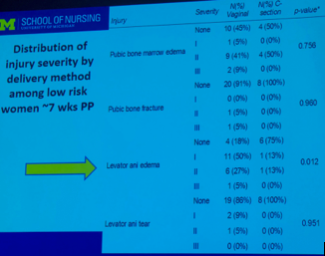EMRLD study aimed to compare women with low risk vaginal births to women at risk for pelvic floor disorders after complicated delivery. Levator ani edema was one of the most significant injury outcomes in low risk group (see Figure 1).

Then researchers compared females with low risk vaginal births to women who never delivered vaginally, but received a C-section. Results demonstrate that all differences between 2 groups resolve overtime, but women in low risk vaginal group could develop pelvic floor injuries which women in a C-section don’t usually get (Figure 2).

In addition, Dr. Low presented a midwife perspective on reducing risk of urinary incontinence and trauma to the pelvic floor after birth. According to the presenter, these issues could potentially be addressed by changing birthing position from supine to sitting up to minimize pelvic constraints, performing self-directed pushing to avoid prolonged pushing, which can lead to urge incontinence in the future, and altering pushing time to reduce risk of tears.
Presented by: Lisa K Low, PhD, CNM, FACNM, FAAN, Associate Professor, School of Nursing, Women’s Studies, Dept. Obstetrics and Gynecology, University of Michigan
Written by: Hanna Stambakio, BS, Clinical Research Coordinator, Division of Urology, University of Pennsylvania, Twitter: @PennUrology at the 2018 ICS International Continence Society Meeting - August 28 - 31, 2018 – Philadelphia, PA USA


